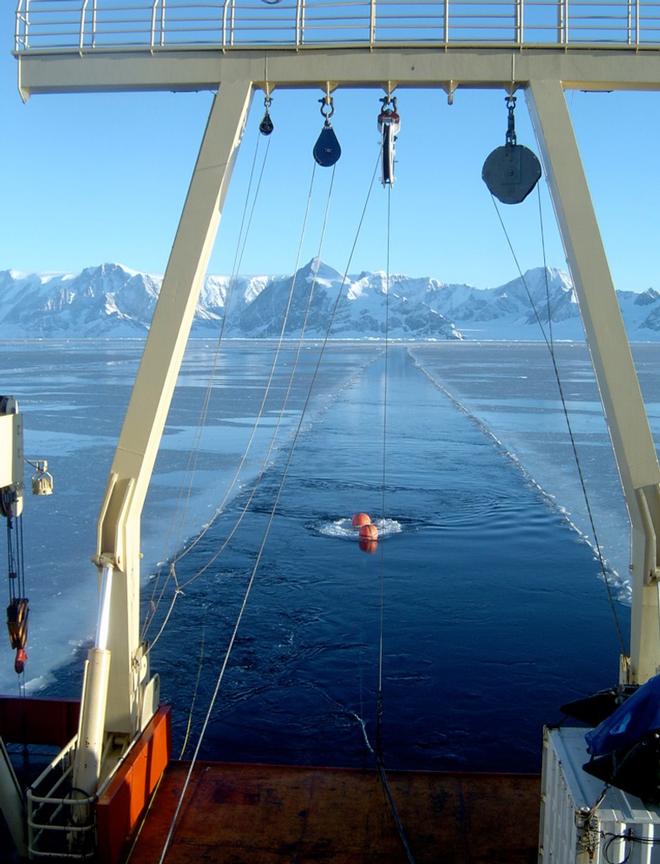Antarctic Team discovers mechanism for massive ice shelf collapse
by British Antarctic Survey on 14 Sep 2014

View looking southwest of the seismic reflection system being towed through the water behind the RVIB N. B. Palmer. The Nordenskold Coast is in the background. Michele Rebesco, 2006
New research has found that the cataclysmic break-up of a large floating ice shelf in the early 2000’s was primarily the result of a rise in air temperature and melting at the surface of the ice, rather than a rapid change in the structure of the glacier.
An international team of scientists, including the British Antarctic Survey, studied the geologic history of the area of the Antarctic Peninsula where the Larsen B ice shelf disintegrated, the portion of Antarctica that extends northwards toward South America.
The new findings support the idea that such a dramatic collapse can be caused by surface warming of the ice and its after-effects, such as the development of melt ponds and crevasses, or cracks, in the surface of the ice that allow warmer water to infiltrate down into the ice.
One other known cause of ice shelf collapse is the under-cutting of the bottom of an ice shelf by relatively warm ocean water, which scientists have demonstrated is occurring elsewhere in Antarctica and in Greenland. In these cases, the ocean water warms and cuts away at the underside of the shelf itself, at the grounding line, where the ice shelf and sea floor meet. The shelf is then weakened from below and may eventually break away.
However, the new study, published in Science this week, indicates that most of the changes at the base of the Larsen B ice shelf had already occurred at the end of the last ice age and that an entirely different mechanism caused the Larsen B to collapse.
Co-author Dr James Smith, marine geologist at the British Antarctic Survey explains: 'Our results show that the ice lost contact with the bed about 12,000 years ago which strengthens the idea that surface processes rather than grounding zone instability controlled the disintegration of Larsen B Ice Shelf in 2002.
'Our data provides unparalleled detail of the zone marking the transition between ice resting on bedrock and full flotation. These ‘grounding zones’ are critical to ice sheet stability as they regulate the flow of continental ice into the ocean.
'However, because they are difficult to access we do not know enough about them and this limits our ability to predict changes in response to warming temperatures or rising sea-level. The collapse of Larsen B Ice Shelf in 2002 provided a unique opportunity to map and sample such an area in detail.'
Lead author, Eugene Domack, professor of geological oceanography at the University of South Florida, said:
'Now, we can recognise two distinct mechanisms for the destabilisation of ice shelves. This research gives us at least two 'devils’ to worry about.'
The new research, Domack noted, does not negate the model in which ice shelves are undercut at the grounding line, but simply includes a new possibility for scientists to consider when studying ice-shelf dynamics.
'Grounding line systems need to be studied in more detail and need to be sampled directly in order to understand how a large ice mass behaves under changes in ocean temperature and sea level rise.'
The new work has major implications for the study of ice-sheet dynamics, which, in turn, are important in understanding how the vast Antarctic ice sheets will behave, as global temperatures increase. Ice shelves play a vital role in the behaviour of the enormous mass of freshwater ice that covers the Antarctic continent, acting as dams that regulate the flow of ice into the sea.
The research was supported by a grant from the Division of Polar Programs in NSF's Geosciences Directorate.
If you want to link to this article then please use this URL: www.sail-world.com/126664